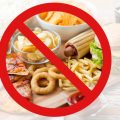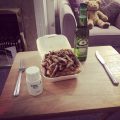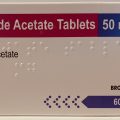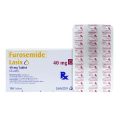Anastrozole is in a class of medications called nonsteroidal aromatase inhibitors. It works by decreasing the amount of estrogen the body makes. This can slow or stop the growth of many types of breast cancer cells that need estrogen to grow. Anastrozole is used with other treatments, such as surgery or radiation, to treat early breast cancer in women who have experienced menopause (change of life; end of monthly menstrual periods).
This medication is also used in women, who have experienced menopause, as a first treatment of breast cancer that has spread within the breast or to other areas of the body. This medication is also used to treat breast cancer in women whose breast cancer has worsened after taking tamoxifen (Nolvadex).
How should this medicine be used?
Anastrozole comes as a tablet to take by mouth. It is usually taken once a day with or without food. Take anastrozole at around the same time every day. Follow the directions on your prescription label carefully, and ask your doctor or pharmacist to explain any part you do not understand. Take anastrozole exactly as directed. Do not take more or less of it or take it more often than prescribed by your doctor.
You may need to take anastrozole for several years or longer. Continue to take anastrozole even if you feel well. Do not stop taking anastrozole without talking to your doctor. Ask your pharmacist or doctor for a copy of the manufacturer’s information for the patient.
What foods should be avoided with Anastrozole?
Taking a medicine at the same time you eat can cause your body not to absorb the medicine. Or certain foods may delay or decrease the absorption of the drug.
Some medicines cannot be taken with certain types of food. The food can cause a reaction that changes the effect of the medicine. It also can create or heighten side effects. When taking Anastrozole, avoid raw fruits, vegetables, whole-grain breads, cereals, and seeds.
Oncologist usually recommend eating low-fiber, bland foods, such as white rice and boiled or baked chicken. Soluble fiber is found in some foods and absorbs fluid, which can help relieve diarrhea associated side effects of this drug.
Foods high in soluble fiber include applesauce, bananas (ripe), canned fruit, orange sections, boiled potatoes, white rice, products made with white flour, oatmeal, cream of rice, cream of wheat, and farina. Drink 8-10 glasses of non-alcoholic, un-caffeinated fluid a day to prevent dehydration.
What are the other side effects of Anastrozole?
Check with your doctor immediately if any of the following side effects occur:
More common
- Blurred vision
- bone pain
- chest pain or discomfort
- dizziness
- headache
- nervousness
- pounding in the ears
- slow or fast heartbeat
- swelling of the feet or lower legs.
Less common
- Arm, back, or jaw pain
- chest tightness or heaviness
- chills
- cough
- cough producing mucus
- difficult or painful urination
- difficulty breathing
- dizziness, severe
- fever
- headache, continuing
- hoarseness
- increased blood pressure
- lower back or side pain
- nausea
- pain, tenderness, bluish color, or swelling of the foot or leg
- sore throat
- sweating
- unusual drowsiness, dullness, tiredness, weakness, or feeling of sluggishness
- vaginal bleeding (unexpected and heavy).
Incidence not known
- Blistering, peeling, or loosening of the skin
- confusion
- constipation
- dark urine
- depression
- diarrhea
- difficulty swallowing
- dry mouth
- general tiredness and weakness
- hives or welts, itching, skin rash
- incoherent speech
- increased urination
- joint or muscle pain
- large, hive-like swelling on the face, eyelids, lips, tongue, throat, hands, legs, feet, or genitals
- light-colored stools
- loss of appetite
- metallic taste
- muscle weakness
- puffiness or swelling of the eyelids or around the eyes, face, lips, or tongue
- red skin lesions, often with a purple center
- red, irritated eyes
- sores, ulcers, or white spots in the mouth or on the lips
- stomach pain
- thirst
- upper right abdominal pain
- vomiting
- weight loss
- yellow eyes and skin.
Some side effects may occur that usually do not need medical attention. These side effects may go away during treatment as your body adjusts to the medicine. Also, your health care professional may be able to tell you about ways to prevent or reduce some of these side effects. Check with your health care professional if any of the following side effects continue or are bothersome or if you have any questions about them:
More common
- Back pain
- belching
- body aches or pain
- congestion
- decrease in height
- feeling of warmth
- flushing or redness of the skin, especially on the face and neck
- heartburn
- increased appetite
- indigestion
- lack or loss of strength
- mood or mental changes
- pain in the back, ribs, arms, or legs
- pain, general
- pelvic pain
- runny nose
- stomach discomfort or upset
- tender, swollen glands in the neck
- trouble in swallowing
- voice changes.
Less common
- Anxiety
- breast pain
- dryness of the vagina
- general feeling of discomfort or illness
- joint stiffness
- loss of hair
- numbness or tingling of the hands or feet
- shivering
- sleepiness
- trouble sleeping
- weight gain.
Incidence not known
- Difficulty in moving
- muscle cramps or stiffness
- swollen joints.
Other side effects not listed may also occur in some patients. If you notice any other effects, check with your healthcare professional.
Call your doctor for medical advice about side effects. You may report side effects to the FDA at 1-800-FDA-1088.






